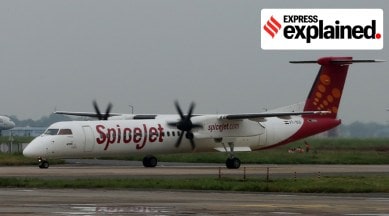Explained: Why flights face turbulence
Injuries to passengers of a SpiceJet flight to Durgapur raise questions. What should you do on a bumpy flight?

On Sunday, a SpiceJet-operated Boeing 737-800 aircraft with 189 passengers, two pilots and four cabin crew members encountered “severe turbulence” two hours after it took off from Mumbai at around 5.13 pm. On its descent to Durgapur in West Bengal, less than 200 km outside the airport, it flew into bad weather that caused the turbulence, resulting in sharply varying g-forces on the plane. The airspeed suddenly dropped by around 100 knots before rising again. This caused passengers and crew to rise up almost as if in a zero-gravity situation and then getting slammed back down, all in a matter of minutes.
The plane landed safely at Durgapur around 7.15 pm, but many of those on board were injured, some seriously. Two people are in intensive care and being treated for head and spine injuries. India’s aviation safety regulator has deployed a multi-disciplinary team to carry out an investigation. The probe will look to answer crucial questions in an effort to prevent such future incidents, including why the aircraft flew into such weather, why people got injured so badly, and whether the crew contributed to the event in any manner.
What happens when a flight encounters turbulence?
Are turbulence incidents dangerous?
It depends on their nature and intensity. Aircraft undergo some form of turbulence on a regular basis and pilots are trained to deal with these. However, there have been several instances when turbulence has brought down modern jetliners. Even in these cases, while intense turbulence has been the main cause of an accident, several other factors — such as lack of proper training, poor dissemination of weather or wind related information — have contributed to the accident.
According to a Director General of Civil Aviation (DGCA) official: “During descent, the aircraft experienced severe turbulence and the vertical load factor varied from +2.64G and -1.36G. During this period, the autopilot got disengaged for two minutes and the crew manually flew the aircraft”. G refers to g-force, or gravitational force equivalent, which in normal flying conditions is 1G. A negative G value indicates that the aircraft was accelerating downwards faster than the rate of natural freefall, giving the feeling of weightlessness.
What will the investigation focus on?
As a standard practice, it will focus on a number of factors to ascertain why the incident caused severe injuries to passengers. These include the weather conditions when the plane encountered turbulence, whether or not the pilots were caught unprepared, and whether they asked the cabin to prepare for the incoming disturbance.
What must passengers do when an aircraft encounters turbulence?
According to the US Federal Aviation Administration (FAA), “passengers can easily prevent injuries from unexpected turbulence by keeping their seat belt buckled at all times”. It suggests passengers should listen to instructions from flight attendants; pay attention to the safety briefing at the beginning of the flight; wear a seat belt at all times; use an approved child safety seat or device if a child is under two; and adhere to carry-on restrictions.
How can airlines avoid turbulence?
The FAA recommends that carriers improve dispatch procedures by keeping communication channels open full-time; include turbulence in weather briefings; promote real-time information sharing between pilot and dispatcher; reinforce the carrier’s turbulence avoidance policy through dispatcher training; consider rerouting using atmospheric modelling, and data displays; and use all applicable weather data. It also suggests using operating procedures and training to prevent turbulence injuries, emphasising the importance of flight attendant’s personal safety, promoting communication and coordination, and gathering data and reviewing the air carrier’s history of turbulence encounters and injuries.
Explained: The 7 kinds of turbulence
WIND SHEAR: Happens when there is a sudden change in wind direction, whether vertically or horizontally. Typically occurs close to thunderstorms, jet streams, etc.; tricky for pilots as tailwinds suddenly change to headwinds or vice versa.
FRONTAL: Created in frontal zone when warm air is lifted by sloping frontal surface and friction between opposing air masses. Most palpable when warm air is moist; intensity increases with thunderstorms. Most common close to thunderstorms.
CONVECTIVE: When land surface temperature rises, the air above the ground heats up and rises, creating air pockets around it. Convection currents cause difficulties during approach as they tend to affect the rate of descent.
WAKE: Forms behind an aircraft when it flies through air-creating wingtip vortices. Can be dangerous for small aircraft following bigger ones, which tend to disrupt the airflow more strongly in their wake.
MECHANICAL: This type of turbulence occurs when tall solid objects such as mountains or highrise constructions disrupt the normal airflow, causing the air for planes to fly through to become dirty.
CLEAR AIR: Occurs when an aircraft crosses from one air mass to another, which has a different direction. Clear air turbulence could also happen when an aircraft moves out of a jet stream.
MOUNTAIN WAVE: One of the most severe; these are oscillations that form on the downwind side of mountains when strong winds flow towards mountains in a perpendicular fashion. Aircraft tracking perpendicularly across, or downwind of a mountain, may experience sudden loss of altitude followed by a sudden reduction in airspeed.
Newsletter | Click to get the day’s best explainers in your inbox